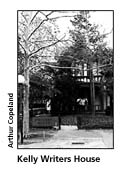
Creating a Culture of Writing at Penn
The New Writing Program and a $1.1 Million Dollar Gift to Renovate the
Writers House

The University has always recognized the importance of writing. Ideally, every student should have the opportunity to learn to write well. In the College, students who must fulfill a basic writing requirement are able to choose from a rich variety of writing-intensive courses. Students take "Writing About" seminars in many departments outside English, including art history, folklore, sociology, psychology, classical studies and others. The Writing Across the University program also extends the realm of writing courses beyond the English department. And for those who need help with their assignments, the Writing Center and its Writing Fellows offer one-on-one consulting at Bennett Hall and in several residences.
This year, these programs, which in the past have functioned independently from one another, have been united as the newly reorganized Penn Writing Program. To help meet the Writing Program's goal of providing "full coverage" advising for the entire University, the writing advisors program will be enlarged to cover even more of the undergraduate residential communities, and will be further expanded by an electronic writing advising service that operates 24 hours a day, seven days a week. Currently in a pilot phase, the system is fully interactive. Students may consult at any time with an on-line writing advisor whose suggestions are monitored by faculty. Penn is one of the few universities in the country employing an on-line writing advising system and is perhaps the only one offering such complete coverage. All of these efforts, explains Alan Filreis, the professor of English who is also the director of the Penn Writing Program, are steps to creating a "culture of writing" at Penn, one he says is "characterized by an active concern for clear thinking realized through the written word."
Peshe Kuriloff, Director of the Writing Across the University program, founded the writing advisor program which trains undergraduates to tutor their peers in the residences during evening and weekend hours. "We're focused on trying to give writing a higher profile. Most people agree it's an essential skill and should be a major component of a liberal arts education." But often, she notes, alumni tell her they avoided taking writing classes, only to end up spending several years in their jobs learning to write. To counter that trend, "We're doing everything we can to encourage students to seek out writing opportunities. We need to create an environment in which writing is done regularly and emphasized and valued."
In addition to the new Writing Program, writing at Penn received another boost with the announcement that Paul K. Kelly (C'62, WG'64), president and chief executive officer of Knox & Co., an investment banking firm, has given $1.1 million to renovate the Writers House at 3805 Locust Walk. Part of Kelly's gift will be used to rewire the building - the former home of the University Chaplain - for desktop publishing. The state-of-the-art facility has been renamed Kelly Writers House, in honor of the donor's parents. The major part of the renovation will be done over the summer with completion by mid-October. Writers House encourages student authors and provides an intellectual and academic base for social activities related to writing and literature. It hosts visits by both young and eminent writers and sponsors readings, seminars, workshops, and live performances. One Saturday night each month readings are broadcast live on WXPN.
Although Kelly Writers House is not affiliated with any one department, says Filreis, "it further expands our culture of writing. Students who like to write hang out there and it's a good place for the Writing Program to do some of its off-site or residentially based work." This semester alone some 180 scheduled events will make it possible for students to meet writers of various kinds: journalists, fiction writers, poets, dramatists.
Special workshops conducted by Penn writers and visiting editors will teach skills in the design of electronic texts and electronic publishing. "Paul Kelly is also going to help us make connections between the undergraduates who visit the Writers House and the community of editors and book publishers who are Penn alumni," states Filreis. "He's helping us to think of the Writer's House as also a place where Penn students can think of career options in the context of actual writing practices."
Filreis is also excited by the potential of the electronic writing advising system, which he hopes eventually will be available to all Penn undergraduates, faculty, staff and alumni. At any time, day or night, the user can send an e-mail question to the trained advisors, who log it and reply, usually within several hours.
"Residentially based writing advising and electronic writing advising are initiatives that strongly suggest our notion that writing is something students don't just do in a course. Even those enrolled in writing seminars do more writing outside class than in. And lucid, skilled writing obviously extends well beyond any individual course. Alumni realize it as a life-long activity. We want to be able to respond to that need as well."
Plans are also underway for the "culture of writing" to expand beyond the campus through several distance-learning projects. Currently, the Writing Program is co-sponsoring an on-line "Writing the Essay" course with Alumni Relations - an effort similar to Filreis's popular Internet poetry course. In the future, the Program, through the College of General Studies, hopes to offer a non-credit "virtual writing" class for high school juniors. "We want to involve writers and audiences," says Kuriloff, "who wouldn't have access to instruction or to a readership in any other way. Distance learning has a lot of potential; it's perfect for alumni."